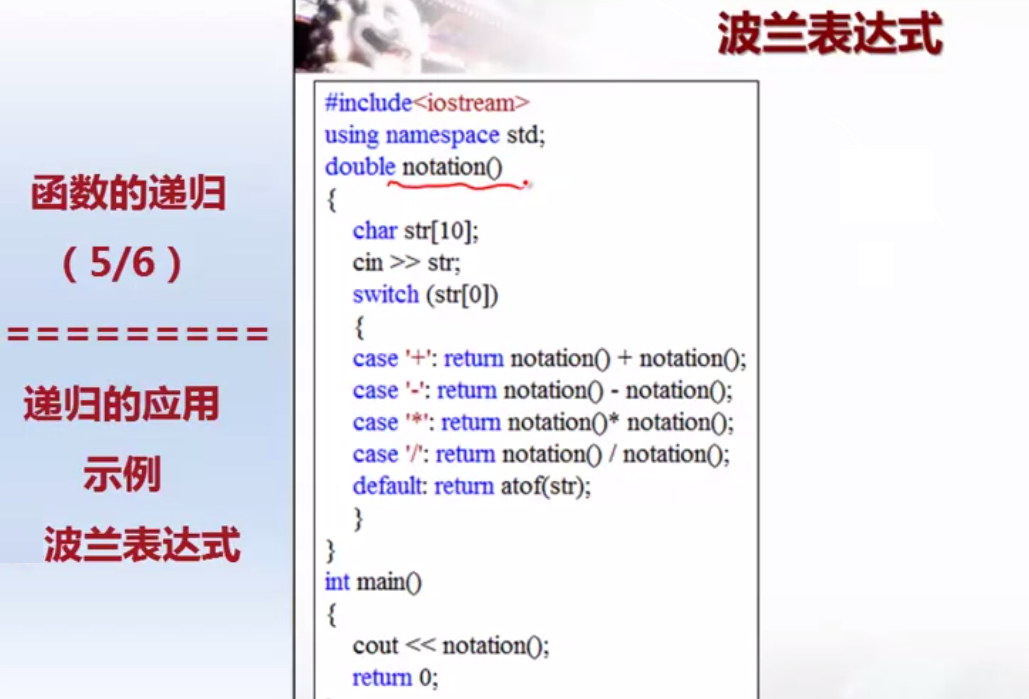栈的分类
- 栈分为顺序栈和链栈
顺序栈的定义
typedef struct{
int data[MAXSIZE];
int top;
}Sqstack;一般情况下,栈更多的是应用到具体的实现,下面我们结合几个例子来展示栈的各种操作
- 括号匹配问题
Input:Only ’ ( ’ , ’ ) ’ , ’ [ ’ , ’ ] ‘
#ifndef STACK_H_
#define STACK_H_
#endif
#include <iostream>
#include <cstdio>
#include <cstdlib>
#define MAX 32
using namespace std;
typedef struct{
char data[MAX];
int top;
}SqStack;
void InitStack(SqStack * s)
{
s->top = -1;
}
void Pop(SqStack * s)
{
s->top--;
}
void Push(SqStack * s,char ch)
{
s->data[++s->top] = ch;
}
char getTop(SqStack * s)
{
return s->data[s->top];
}
bool comp(SqStack * s, char ch)
{
switch(ch)
{
case ')':
if (getTop(s) == '(')
return true;
return false;
case ']':
if (getTop(s) == '[')
return true;
return false;
}
}
int main()
{
SqStack s;
char str[MAX];
gets(str);
InitStack(&s);
for (int i = 0; str[i] != '\0'; ++i)
{
/*directly push into stack*/
if (str[i] == '(' || str[i] == '[')
Push(&s,str[i]);
else
{
/*stack is empty means not match*/
if (s.top == -1)
{
printf("Do not match!");
exit(-1);
}
/*compare if the top element match the current*/
else if (comp(&s,str[i]))
{
Pop(&s);
}
else
{
printf("Do not match!");
exit(-1);
}
}
}
if (s.top != -1)
{
printf("Do not match!\n");
}
if (s.top == -1)
{
printf("Match!\n");
}
return 0;
}- 数值进制转换问题
/*n represent the value to be transformed,m represent the base*/
void transfer(SqStack * s, int n)
{
InitStack(s);
while(n)
{
Push(s,n % m);
n = n / m;
}
while(!isEmpty(s))
{
putchar(s->data[s->top--]);
}
}- 行编辑问题
#include <iostream>
#include <cstdio>
#include <cstdlib>
#define MAX 10000
using namespace std;
typedef struct{
char data[MAX];
int top;
}SqStack;
bool isEmpty(SqStack * s)
{
if (s->top == -1)
return true;
return false;
}
void ClearStack(SqStack * s)
{
s->top = -1;
}
void InitStack(SqStack * s)
{
s->top = -1;
}
void Pop(SqStack * s)
{
s->top--;
}
void Push(SqStack * s,char ch)
{
s->data[++s->top] = ch;
}
void EditLine(SqStack * s)
{
InitStack(s);
char ch;
ch = getchar();
while (true) //or while(ch != EOF)
{
while(ch != EOF && ch != '\n')
{
switch(ch)
{
case '#':
Pop(s);
break;
case '@':
ClearStack(s);
break;
default:
Push(s,ch);
}
ch = getchar();
}
/*Output the line after edited*/
for (int i = 0; i <= s->top; ++i)
printf("%c",s->data[i]);
printf("\n");
/*Clear the stack*/
ClearStack(s);
if (ch != EOF)
ch = getchar();
/*if the outer loop wrote like "while(ch != EOF)" the break needn't*/
break;
}
}
int main()
{
SqStack s;
EditLine(&s);
return 0;
}- 简单的四则元算
//To be continued...- 前缀表达式处理计算
- 链栈的定义
typedef struct LNode
{
int data;
struct LNode * next;
}LNode;- 链栈的初始化
void InitStack(LNode * lst)
{
lst = (LNode *)malloc(sizeof(LNode));
lst->next = NULL;
}- 判空函数
bool isEmpty(LNode * lst)
{
if (lst->next == NULL)
return true;
return false;
}- 进栈操作
void Push(LNode * lst, int x)
{
LNode * p;
p = (LNode *)malloc(sizeof(LNode));
p->data = x;
p->next = lst->next;
lst->next = p;
}- 出栈操作
void Pop(LNode * lst)
{
LNode * p;
if (lst->next == NULL)
/*Empty*/
exit(-1);
p = lst->next;
lst->next = p->next;
free(p);
}队列
队列分为链式队列和循环队列
- 链式队列
/*队列节点*/
typedef struct Node
{
int data; /*数据域*/
struct Node *next; /*指针域*/
}LinkQueueNode;
/*链队类型*/
typedef struct
{
LinkQueueNode *front;
LinkQueueNode *rear;
}LinkQueue;int InitQueue(LinkQueue *Q)
{
/* 将Q初始化为一个空的链队列 */
Q->front=(LinkQueueNode *)malloc(sizeof(LinkQueueNode));
if(Q->front!=NULL)
{
Q->rear=Q->front;
Q->front->next=NULL;
return(TRUE);
}
else return(FALSE); /* 溢出!*/
}void EnQueue(LinkQueue *Q, int e)
{
LinkQueueNode * p;
p = (LinkQueueNode *)malloc(sizeof(LinkQueueNode));
if (p != NULL)
{
p->data = e;
Q->rear->next = p;
Q->rear = p;
Q->rear->next = NULL;
}
}void DeQueue(LinkQueue *Q, int &e)
{
LinkQueueNode *p;
p = Q->front->next;
Q->front->next = p->next;
e = p->data;
if (Q->rear == p)
Q->rear = Q->front;
free(p);
}- 循环队列
/*define*/
typedef struct{
int data[MAXSIZE]; /*队列的元素空间*/
int front; /*头指针指示器*/
int rear; /*尾指针指示器*/
}SqQueue;void InitSqQueue(SqQueue * Q)
{
/* 将*Q初始化为一个空的循环队列 */
Q->front = Q->rear = NULL;
}void EnSqQueue(SqQueue * Q, int e)
{
if ((Q->rear + 1) % MAXSIZE == Q->front)
return QUEUE_FULL;
Q->data[Q->rear] = e;
Q->rear = (Q->rear + 1) % MAXSIZE;
}void DeSqQueue(SqQueue * Q, int & e)
{
if (Q->rear == Q->front)
return QUEUE_EMPTY;
e = Q->data[Q->front];
Q->front = (Q->front + 1) % MAXSIZE;
}int GetSqQueueLength(SqQueue * Q)
{
return (Q->rear - Q->front + MAXSIZE) % MAXSIZE;
}

























 被折叠的 条评论
为什么被折叠?
被折叠的 条评论
为什么被折叠?








